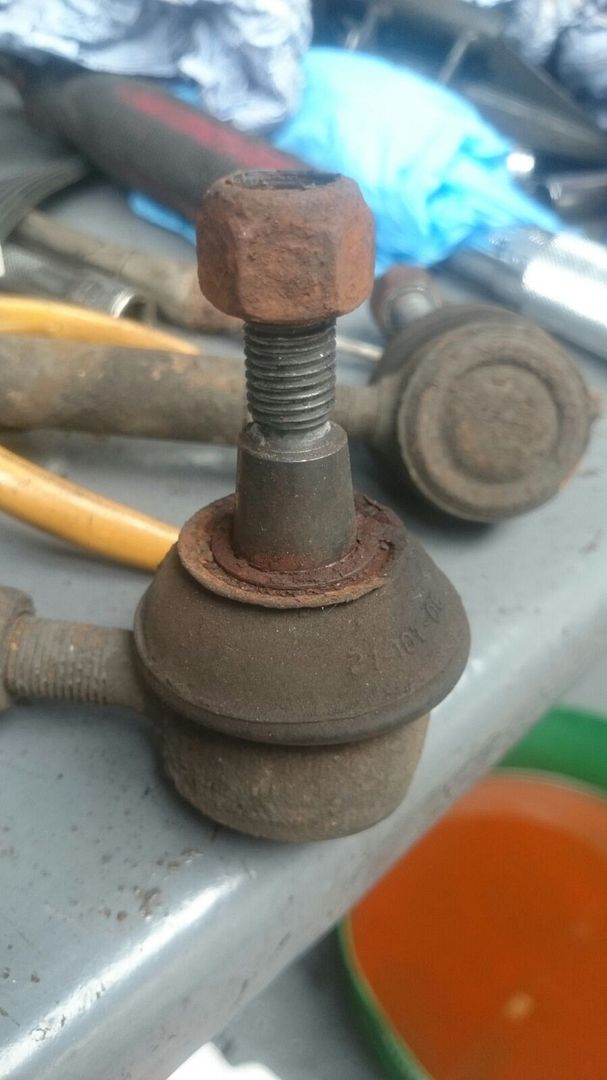Need to order some toe links but I recall you need to know which sort of joint you have.
I have read a million times about tapered or parallel joints over the years but never been sure what it is exactly or how you tell what you have?

Posted 01 September 2016 - 03:46 PM
Need to order some toe links but I recall you need to know which sort of joint you have.
I have read a million times about tapered or parallel joints over the years but never been sure what it is exactly or how you tell what you have?
Posted 01 September 2016 - 04:33 PM
I may be wrong, but I have a feeling the older cars have tapered, newer ones have parrallel. This means most NAs are tapered, and most VXTs are parallel.
Needs confirming though as Im only 75% certain.
Posted 01 September 2016 - 04:43 PM
Close, but other way around ![]()
Early: parallel
Late: tapered
Crash-repaired cars: any guess...
The parallel ones will have a shim/spacer between the upright and the balljoint that partly sits in a recess in the upright on the outboard end that the tapered ones lack.
Bye, Arno.
Posted 01 September 2016 - 04:49 PM
Err yeah..... ![]()
Early ones are M10 recessed and the later ones are M12 tapered.
So early NA's should be recessed and the later tapered and the same with the Turbo but with a much smaller % as the cars were introduced later.
However we had a customer last week with tapered on a 2002 NA and I have seen cars with one of each at the rear!
By the time you add a few repair jobs and a few track specials it's hard to be sure without checking which is why we always confirm this before building a toe link kit.
If you message me on here Tony I will show you how to check for sure.
![]()
Gaz
Posted 01 September 2016 - 05:05 PM
Although mines a 53 plate NA with M10 recessed.
Posted 01 September 2016 - 08:33 PM
While on the topic, for sure the parallel one was replaced due to quality issues. So has anyone ever have a tapered toe link arm snap or is this well known problem only related to the early type. Basically has the inner joint ever snapped for someone since I cant imagine the tapered joint ever failing?
Posted 01 September 2016 - 09:13 PM
While on the topic, for sure the parallel one was replaced due to quality issues. So has anyone ever have a tapered toe link arm snap or is this well known problem only related to the early type. Basically has the inner joint ever snapped for someone since I cant imagine the tapered joint ever failing?
I'm not sure they were quality issues as such, certainly Lotus upgraded these in several stages which is one of the problems with the VX subframe as it simply cannot take the higher loading of an uprated fastener into the subframe. The VX subframe ball joint torque remained at 47nm when the Elise went right up to 72nm at one stage with a very high tensile ball joint. This was later reduced again to 65nm so there is a message in there as well!
The standard units tend to snap on the threaded section once the ball joint has started to bind so the section inside the upright is not so relevant though we have seen failures of the outer ball joints as well, certainly the superior form and weld quality of the later ball joints helped alleviate this issue.
The other failure is where a worn joint has popped off the ball, both failures are catastrophic in nature
So in answer to your question, yes they do still fail as the section inside the upright is not the section of the link that usually fails. Failure can be on the inner or the outer ball joints and can be on either the threaded section or with the complete seperation of the joint, also as mentioned at the outer vertical section of the earlier M10 joints.
Uprated kits solve or reduce several of these problems, the reliability of quality rod ends reduce the possibility of binding and as the joint is also open to inspection (unlike ball joints) it is easier to see a problem quite early and take appropriate action. Secondly the subframe bracket increases the support for the fastener and also keeps it captive should the joint suffer severe damage.
The option of different outer fasteners (M12, 10.9 spec bolts) gives added strength over the the ball joint components.
I use "ball joints" loosely of course, all the above units are ball joints but I use the notation to differentiate between the rod ends of an uprated kit.
![]()
Gaz
![]()
Posted 02 September 2016 - 06:25 AM
Good info Gaz!
But just for clarity, when you say the [color=rgb(40,40,40);font-family:helvetica, arial, sans-serif;]threaded section fails do you refer to the section that goes in to the chassis and hub or also the adjusting thread that goes in to the tube?[/color]
Posted 02 September 2016 - 09:34 AM
Good info Gaz!
But just for clarity, when you say the [color=rgb(40,40,40);font-family:helvetica, arial, sans-serif;]threaded section fails do you refer to the section that goes in to the chassis and hub or also the adjusting thread that goes in to the tube?[/color]
The greater majority of failures are at the base of the adjusting thread, either on the weld or where it meets the housing. This is obvious really as when the unit starts to bind the toe link rod is acting as a lever so it is exactly the same principal as using any spanner or wrench.
When newer units fail it is because it is the thinnest section and the first to deform when overloaded.
![]()
Posted 02 September 2016 - 04:58 PM
Mine did this: 
Posted 02 September 2016 - 05:02 PM
Mine did this:
Ouch!
Outer??
Posted 02 September 2016 - 05:04 PM
Yes
Posted 02 September 2016 - 05:07 PM
Classic
What now?
History? how old, how/when did it fail please.
![]()
Edited by Spitfire Engineering, 02 September 2016 - 05:11 PM.
Posted 03 September 2016 - 08:56 AM
This was 3 or 4 years ago at a Walshy day so it had been subject to high speed turns all day. It was about 7 years old with <40k miles. Replaced it with standard parallel and has been fine since.
Posted 03 September 2016 - 10:32 AM
This was 3 or 4 years ago at a Walshy day so it had been subject to high speed turns all day. It was about 7 years old with <40k miles. Replaced it with standard parallel and has been fine since.
Ta, all good info
![]()
Gaz
Posted 04 September 2016 - 06:43 AM


Posted 04 September 2016 - 09:40 AM
Posted 04 September 2016 - 09:42 AM
Thanks for that cressey! I do remember it had a surprisingly small flanged nut. So I must have parallel. That's saved a trip to the lock up thank you very much!
Not necessarily, the M12 also came with a flanged nut that has the same AF as the normal M10 nut!
better to check the thread itself.
![]()
Posted 04 September 2016 - 09:56 AM
Posted 04 September 2016 - 10:04 AM
Ok lol. Is the spacer definitive because mine did have a spacer too under the nut?
Yes it is, the later tapered M12 units had no spacers or shims as their position if fixed.
With the spacer above it is easy to spot, when the spacer goes under the upright arm it is much harder to identify as it is partially hidden inside the upright and seems to be part of the joint, add to this enough folded rubber, grease and crap to hide almost anything.
![]()
0 members, 1 guests, 0 anonymous users